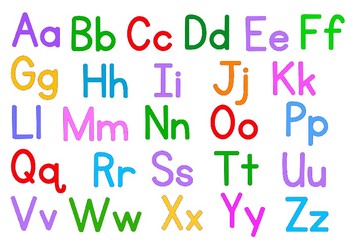The alphabet: Not just for little kids.
Zapped Zs, Alphabet Cities, dozens of cool and unusual alphabets, a lot of great books and projects, and more.
Table of Contents
MOSTLY (BUT NOT ALL) FOR BEGINNERS
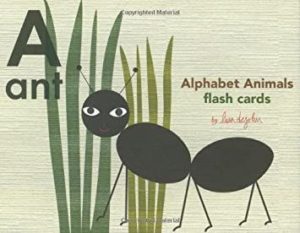 |
Artist Lisa DeJohn’s colorful Alphabet Animals Flash Cards are printed in bright colors on heavy cardboard. Each has a capital alphabet letter, an animal word in lower-case print, and a great animal illustration, from Ant, Blackbird, and Caterpillar, through Mouse, Octopus and Zebra. For ages 1-4. |
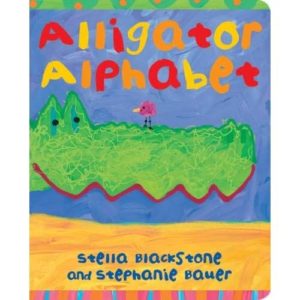 |
In Stella Blackstone’s Alligator Alphabet (Barefoot Books, 2007), kids learn upper- and lower-case letters with a bevy of adorable painted animals (purple bears, turquoise elephants) in bright attractive borders. For ages 1-4. |
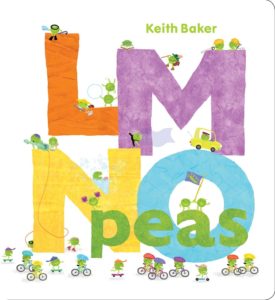 |
Keith Baker’s LMNO Peas (Little Simon, 2014) is filled with imaginative cartoon peas participating in dozens of alphabetical professions. See peas as acrobats, artists, and astronauts; builders, bathers, and bikers; painters, poets, and plumbers; and even – eventually – zoologists. For ages 2-6. |
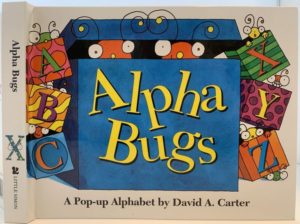 |
By David A. Carter, AlphaBugs (Little Simon, 2006) is a zany collection of pop-ups, pull-tabs, and liftable flaps concealing a lot of wacky alphabetical bugs. (Bubble Bugs. Yo-Yo Bugs.) For ages 2-6. |
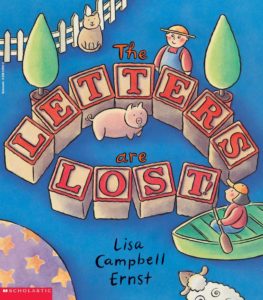 |
In Lisa Campbell Ernst’s The Letters Are Lost (Puffin, 1999), the letters of the alphabet – each represented as an old-fashioned alphabet block – have been scattered: A flew off in an Airplane, B tumbled into the Bath, C joined a family of Cows. By the end, they’re finally all back in order in their box again – but where will they end up next? (Invent your own lost-letter scenarios.) For ages 2-6. |
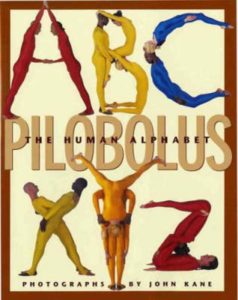 |
In The Human Alphabet (Roaring Brook Press, 2005) by John Kane and the Philobolus Dance Company, dancers in bright-colored leotards take on the shapes of the alphabet letters. For ages 2-6. |
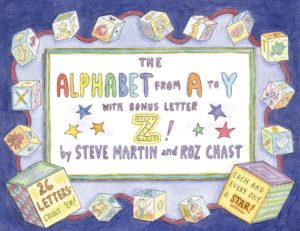 |
Steve Martin’s The Alphabet from A to Y with Bonus Letter Z! (Flying Dolphin Press, 2007) begins with “Amiable Amy, Alice, and Andie/Ate all the anchovy sandwiches handy.” The illustrations, by brilliant cartoonist Roz Chast, are crammed with extra alphabetical goodies: under B, for example, readers can find everything from boomerangs, bears, and buckets to balloons, a ballerina, and a bowling ball. A great vocabulary builder for ages 2-6. |
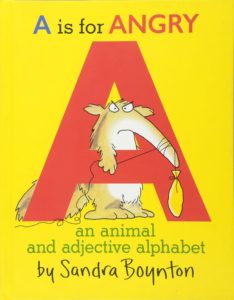 |
Sandra Boynton’s A is for Angry: An Animal and Adjective Alphabet (Workman, 1997) runs from Angry Aardvark (deprived of ants) to Bashful Bear, Frightened Fox, and Zany Zebra (grinning, in pointy yellow party hat). Readers learn the alphabet, a host of animal names, emotion words, and the meaning of “adjective.” For ages 3-5. |
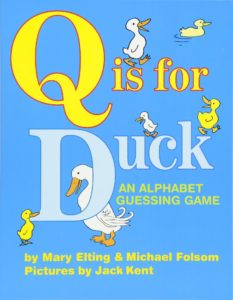 |
Mary Elting’s Q is for Duck (Houghton Mifflin, 1985) is an alphabetical guessing game of animal sounds: Q is for duck because ducks quack. (Now try B is for Dog.) For ages 3-5. |
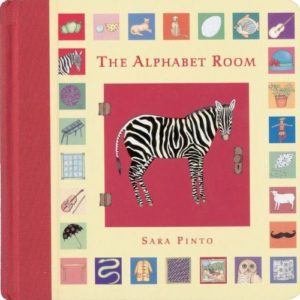 |
In Sara Pinto’s interactive The Alphabet Room (Bloomsbury USA, 2003), A is predictably for Apple and Z for Zebra – but each letter is accompanied by a revealing lift-the-flap door, behind which increasing numbers of labeled objects are continually shuffled and rearranged. (The Cat and Dog play with the Fish; the little Lamb eats Ivy; and the Moustache pops up everywhere.) For ages 3-6. |
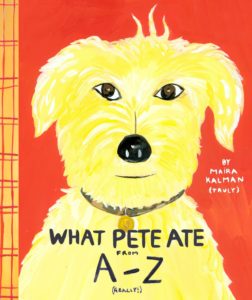 |
In Maira Kalman’s What Pete Ate From A to Z (Puffin, 2003) – subtitled “Where We Explore the English Alphabet (in its entirety) In Which a Certain Dog Devours a Myriad of Items Which He Should Not” – Pete chows down on an astonishing array of alphabetical stuff, beginning with Uncle Rocky’s Accordion. All with explanatory asides from his frustrated, but loving, owner. Funny and clever for ages 3-7. |
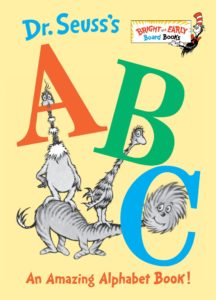 |
Dr. Seuss’s ABC (Random House, 1991) is a zany rhyming alphabet book beginning with “Aunt Annie’s alligator” and ending with “Zizzer-zazzer-zuzz.” Irresistible for ages 3-7. |
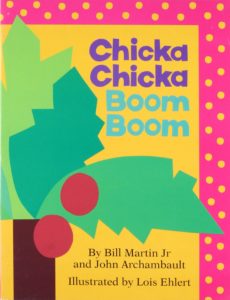 |
Who doesn’t love Bill Martin, Jr., and John Archambault’s catchy Chicka Chicka Boom Boom (Beach Lane Books, 2009): “A told B/and B told C/I’ll meet you at the top/of the coconut tree.” (But 26 letters, it turns out, are a lot to cram into a coconut tree.) For ages 3-7. |
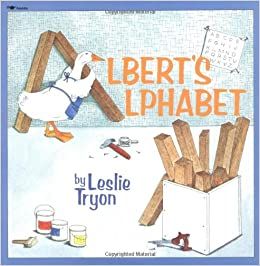 |
In Leslie Tryon’s Albert’s Alphabet (Aladdin, 1994), Albert – the school carpenter and a very creative duck – builds all the letters of the alphabet. For ages 3-7. |
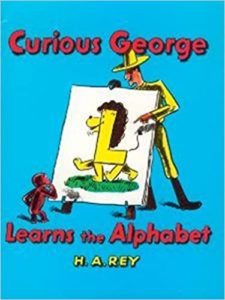 |
In H.A. Rey’s Curious George Learns the Alphabet (Houghton Mifflin Harcourt, 1973), everyone’s favorite little monkey learns the upper- and lower-case letters of the alphabet, with help from the Man in the Yellow Hat. The trick is picture mnemonics: upper-case A, for example, looks like an alligator’s open mouth and lower-case a like a slice of apple; H looks like a house and h like a horse. For ages 3-7. |
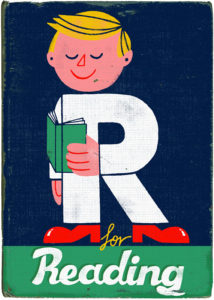 |
By graphic artist Paul Thurlby, Paul Thurlby’s Alphabet (Templar, 2011) has big bright retro-style drawings for each letter of the alphabet. Memory-jogging illustrations include A (for Awesome), E (Embrace), F (Fierce), and R (Rabbit). |
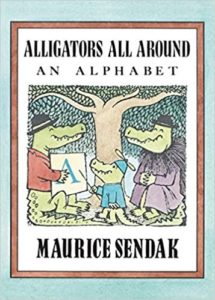 |
Maurice Sendak’s Alligators All Around (HarperCollins, 1991) is a delightful alphabet romp with alligators, in which a family of three variously bursts balloons, catches cold, entertains elephants, makes macaroni, and pushes people. For ages 3-7. |
| From ReadWriteThink, Alliteration All Around is a five-part lesson plan in which kids make their own alliterative alphabet books and write alliterative poetry. (Targeted at grades 3-5.) | |
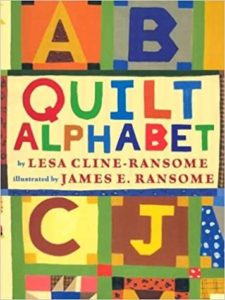 |
In Lesa Cline-Ransome’s Quilt Alphabet (Holiday House, 2002), each letter of the alphabet – framed in a quilt square – is paired with an alphabetical riddle poem and a folk-art painting. Answers are country-cosy: APPLE, COW, KETTLE, PIE, SCARECROW. For ages 3-6. |
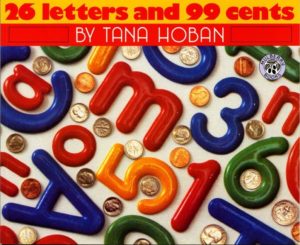 |
In Tana Hoban’s 26 Letters and 99 Cents (Greenwillow Books, 1995), colorful photos of plastic letters are paired with photos of objects – D with a toy dinosaur, F with a goldfish, J with a handful of jellybeans. Flip the book over and it becomes a counting book in the same format. For ages 3-8. |
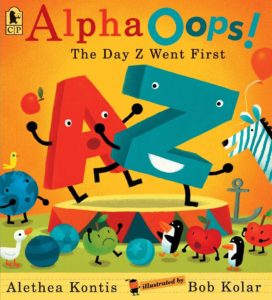 |
In Alethea Kontis’s AlphaOops! (Candlewick, 2012), put-upon Z (“Zebra and I are SICK of this last-in-line stuff!”) creates havoc in the alphabet, until A manages to pull things back together. A delightful read for ages 3-8. |
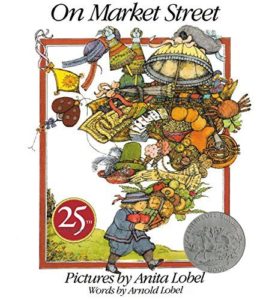 |
Arnold Lobel’s On Market Street (Greenwillow Books, 2006) chronicles in alphabetical order the list of objects a small sailor-suited child buys on Market Street. The illustrations – from apples, books, and clocks to lollipops, playing cards, quilts, and wigs – are wonderful Arcimboldo-type paintings of people made entirely from their wares. For ages 3-8. |
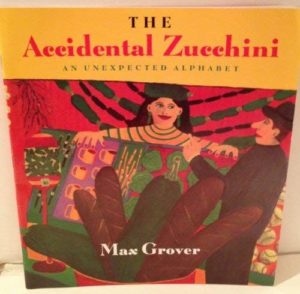 |
Max Grover’s The Accidental Zucchini (Houghton Mifflin Harcourt, 1997) is a wholly unexpected alphabet book, populated with such oddities as apple autos, octopus overalls, and vegetable volcanos. For ages 4-7. |
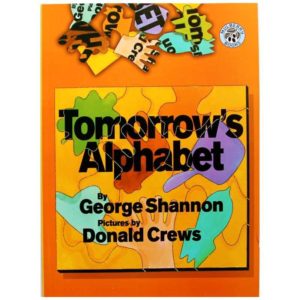 |
In George Shannon’s Tomorrow’s Alphabet (Greenwillow Books, 1999) – as in Mary Elting’s Q is for Duck – letter cues require a little forward thinking. A, for example, is for seed – tomorrow’s APPLE – and D is for puppy, tomorrow’s DOG. For ages 4-8. |
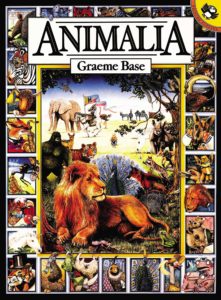 |
Graeme Base’s gorgeously alliterative Animalia (Harry N. Abrams, 1993) includes such alphabetical phrases as “An Armoured Armadillo Avoiding An Angry Alligator” and “Eight Enormous Elephants Expertly Eating Easter Eggs.” For all ages. |
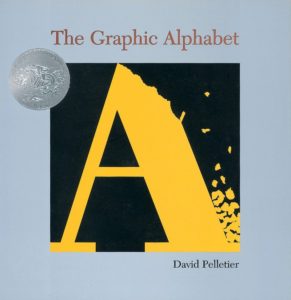 |
In David Pelletier’s The Graphic Alphabet (Scholastic, 1996), a Caldecott Honor book, each page is essentially a concrete poem. A, for example, is an A-shaped mountain, crumbling at the top with a tumbling avalanche. For ages 6 and up. |
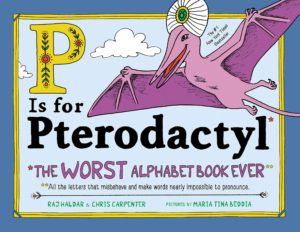 |
By Raj Haldar and Chris Carpenter, P is for Pterodactyl (Sourcebooks, 2018) may just be the worst alphabet book ever, highlighting the wackiness of the English language. Not only is P for Pterodactyl, but A is for Aisle and G is for Gnat. A hoot for all ages. |
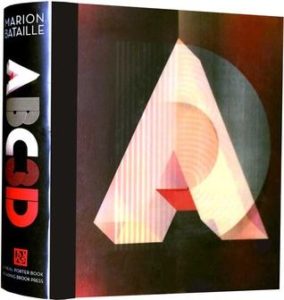 |
Marion Bataille’s ABC3D (Roaring Brook Press, 2008) is a truly spectacular three-dimensional alphabet pop-up book, in elegant red, white, and black. For pop-up fans of all ages. |
| Make your own pop-up alphabet book! |
